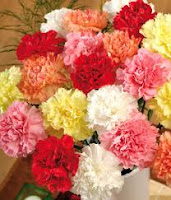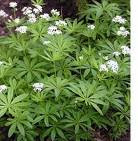Carnations have been cultivated for at least 2,000 years, making it a little difficult to pinpoint where they originated, but it is probable that they came from the Mediterranean region, perhaps Greece
 It is thought that the original carnations were a rich dark pink although no one can be sure. The ancient Greeks used them in garlands and probably ate the edible petals too. In fact they can be substituted in preserves and syrups for rose petals. The petals, but not the bitter parts of the flower head are good in salads and used as garnishes They yield an essential oil used in aromatherapy to calm frazzled nerves and have a soothing effect although at one time the flowers were considered aphrodisiacs.
It is thought that the original carnations were a rich dark pink although no one can be sure. The ancient Greeks used them in garlands and probably ate the edible petals too. In fact they can be substituted in preserves and syrups for rose petals. The petals, but not the bitter parts of the flower head are good in salads and used as garnishes They yield an essential oil used in aromatherapy to calm frazzled nerves and have a soothing effect although at one time the flowers were considered aphrodisiacs. In the late 17th century, the countess of Dorset used carnations in her love potion which consisted of these flowers, bay leaves, marjoram, and lavender. Today the flower head can be dried and mixed in pot-pourri along with a few cloves, sandalwood, rose petals and your other favourite herbs and/or spices. They can also, when dried be placed in sachets and put in wardrobes and drawers to scent clothes and linen.
 Culpeper, in his Herball of the 17th century had this to say of them; carnations “are gallant, fine, temperate flowers…they are great strengtheners of the brain and heart…” In Indian medicine systems they are considered to have anti-spasmodic properties, useful to stop stomach cramps, diaphoretic, promoting sweat in fevers and to reduce other fever symptoms. They are also regarded as a useful heart tonic and as a soothing herb for nervous disorders and stress. They are also thought to counteract the effects of some poisons. However there has been little clinical research to bear out these traditional uses.
Culpeper, in his Herball of the 17th century had this to say of them; carnations “are gallant, fine, temperate flowers…they are great strengtheners of the brain and heart…” In Indian medicine systems they are considered to have anti-spasmodic properties, useful to stop stomach cramps, diaphoretic, promoting sweat in fevers and to reduce other fever symptoms. They are also regarded as a useful heart tonic and as a soothing herb for nervous disorders and stress. They are also thought to counteract the effects of some poisons. However there has been little clinical research to bear out these traditional uses. In the Language of Flowers carnations in general symbolize bonds of affection, health and energy, a fascination for another person and the message they sent was “Alas, my poor heart!” Pink carnations mean “I’ll never forget you!” while red ones symbolize admiration, while sending the message, “My heart aches for you.” Carnations are given on first wedding anniversaries and are traditionally worn as buttonholes at weddings. Oscar Wilde famously wore a green carnation and these are associated by the Irish with Saint Patrick’s Day.
In the Language of Flowers carnations in general symbolize bonds of affection, health and energy, a fascination for another person and the message they sent was “Alas, my poor heart!” Pink carnations mean “I’ll never forget you!” while red ones symbolize admiration, while sending the message, “My heart aches for you.” Carnations are given on first wedding anniversaries and are traditionally worn as buttonholes at weddings. Oscar Wilde famously wore a green carnation and these are associated by the Irish with Saint Patrick’s Day. In Europe in traditional medicine carnations were used for nervous complaints and for the heart, while in China
The pink carnation is said by Christians to have sprung from the Virgin Mary’s tears, and so they symbolize a mother’s undying love for her child.
 Carnations have been candied and used in a liqueur as well as in cocktails. They are the state flower of
Carnations have been candied and used in a liqueur as well as in cocktails. They are the state flower of Shakespeare, Chaucer and Spenser called these flowers both gillyflowers and carnations according to the Encyclopedia Britannica, and Shakespeare coined the verb “incarnadine” from the Italian incarnardino, meaning carnation or flesh-colour, to express the idea of to stain carnation red in Macbeth.
“Will all great Neptune 's ocean wash this blood
Clean from my hand? No; this my hand will rather
The multitudinous seas incarnardine,
Making the green - one red.” Macbeth, Act 2 scene ii.
In “A Winter’s Tale” he writes this line:-
“Of trembling winter, the fairest flowers o' the season are our carnations, and streak'd gillyvors.” – (A Winter's Tale Act 4 scene.iii)
Pablo Neruda the Chilean writer also uses carnation imagery in one of his 100 Love Sonnets
 Sonnet XVII
Sonnet XVII ”I don't love you as if you were the salt-rose, topaz
or arrow of carnations that propagate fire:
I love you as certain dark things are loved,
secretly, between the shadow and the soul.”
Clearly they are a potent symbol in literature and not just that which is written in English. Here is an extract from a Takis Papatsonis poem taken from his second collection of poetry, Ursa Minor, published in 1944.
“You have the courage to adorn yourself
With carnations and I admire you.
Not only because you are lovely
And fresh and they become you
But because you assume the wounds,
You become the image of a legion new martyrs.”
Carnations may not have been the subject of clinical research, but poets and writers have more than made up for this lack.































